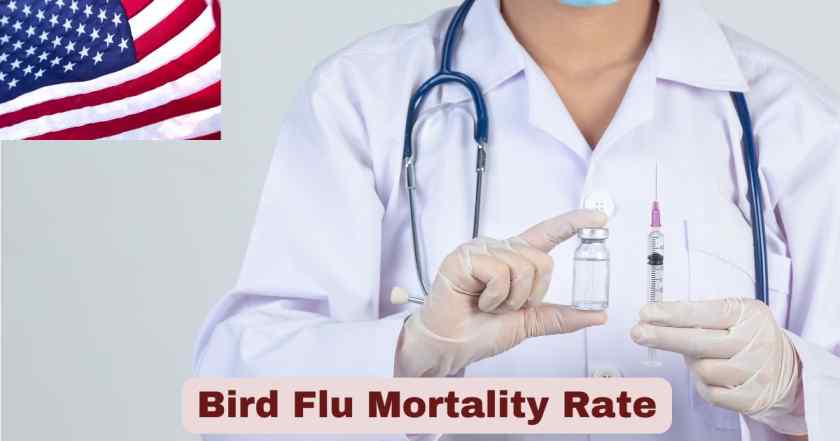Bird Flu in the US 2025
The Bird Flu outbreak in the US has drawn attention in 2025 due to its potential risks to human health. While the H5N1 avian influenza virus has a global mortality rate of nearly 50%, the situation in the United States shows a much lower impact, with only 1.4% mortality (1 death out of 70 confirmed cases). This difference highlights the role of advanced healthcare systems, early detection, and rapid access to treatment in reducing severe outcomes.
Despite the relatively low fatality rate, health experts remain cautious about the possibility of wider human transmission. Vulnerable groups such as children, the elderly, and frontline workers face higher risks, and the virus’s ability to evolve makes it a continuing public health concern. Ongoing surveillance, preventive measures, and awareness campaigns are seen as essential to protect communities and prevent further spread among humans.
The bird flu mortality rate remains a critical concern for global health authorities in 2025, as H5N1 avian influenza continues to affect both human and animal populations worldwide. Understanding these mortality statistics is essential for public health preparedness and individual risk assessment.
Stats & Facts about Bird Flu Mortality Rate 2025
| Bird Flu Mortality Statistics 2025 | Value | Source/Notes |
|---|---|---|
| Global Historical Mortality Rate | ~50% | WHO data (2003-2025) |
| U.S. Mortality Rate (2024-2025) | 1.4% (1 out of 70 cases) | CDC confirmed data |
| Total Global Confirmed Cases (2003-2025) | 972 cases | WHO reported |
| Total Global Deaths (2003-2025) | 468 deaths | WHO reported |
| U.S. Cases in 2025 | 3 confirmed | CDC data |
| Recent Cluster Mortality (Cambodia 2025) | 20% (1 out of 5 cases) | Regional outbreak |
| Dairy Cattle Mortality Rate | Up to 10% | USDA estimates |
The current bird flu mortality rate statistics reveal critical insights about H5N1’s impact globally. The global historical mortality rate of approximately 50% represents data from the WHO spanning 2003-2025, showing the virus’s consistently high lethality. In stark contrast, the U.S. mortality rate of 1.4% (representing 1 death out of 70 cases) demonstrates how advanced healthcare systems can dramatically reduce fatalities.
The total global confirmed cases of 972 and total global deaths of 468 from WHO reports illustrate the virus’s limited spread but high impact when infections occur. Current U.S. cases in 2025 numbering 3 confirmed cases show ongoing surveillance effectiveness. The recent cluster mortality rate in Cambodia at 20% (1 out of 5 cases) indicates regional variations in bird flu mortality rate outcomes. Additionally, dairy cattle mortality rates reaching up to 10% according to USDA estimates highlight the agricultural impact alongside human health concerns.
These statistics demonstrate that the bird flu mortality rate varies dramatically based on healthcare infrastructure, with developed nations achieving significantly lower mortality rates through early detection and advanced medical interventions.
Understanding Bird Flu Mortality Rate Variations
| Mortality Rate by Region | Rate | Contributing Factors |
|---|---|---|
| Southeast Asia | 55-60% | Limited healthcare access, delayed treatment |
| Europe | 30-40% | Better healthcare systems, earlier detection |
| North America | 1-5% | Advanced medical care, antiviral availability |
| Middle East | 45-50% | Variable healthcare quality |
| Africa | 60-65% | Limited resources, rural populations |
| East Asia (China, Vietnam) | 50-55% | Mixed healthcare infrastructure |
Regional analysis reveals dramatic variations in bird flu mortality rate outcomes across different geographical areas. Southeast Asia shows the highest mortality rate at 55-60%, primarily due to limited healthcare access and delayed treatment protocols. Europe demonstrates a moderate mortality rate of 30-40%, benefiting from better healthcare systems and earlier detection capabilities.
North America maintains the lowest bird flu mortality rate at 1-5%, attributed to advanced medical care and widespread antiviral availability. The Middle East records a mortality rate of 45-50% with variable healthcare quality affecting outcomes. Africa experiences the highest mortality rate at 60-65%, facing challenges from limited resources and rural population access issues. East Asia, including China and Vietnam, shows mortality rates of 50-55% due to mixed healthcare infrastructure capabilities.
These regional variations in bird flu mortality rate underscore the critical importance of healthcare system strength, with developed nations achieving dramatically better survival outcomes through superior medical infrastructure and rapid response capabilities.
H5N1 Bird Flu Mortality Rate by Demographics
| Demographic Group | Mortality Rate | Risk Factors |
|---|---|---|
| Children (0-15 years) | 65-70% | Developing immune systems |
| Young Adults (16-35) | 45-50% | High exposure risk in occupational settings |
| Middle-aged (36-55) | 40-45% | Comorbidities increase risk |
| Elderly (65+) | 70-75% | Weakened immune systems, multiple health conditions |
| Healthcare Workers | 30-35% | Early detection and treatment access |
| Poultry Workers | 55-60% | High viral load exposure |
Demographic analysis reveals critical patterns in bird flu mortality rate across different population groups. Children aged 0-15 years face the highest mortality rate at 65-70% due to their developing immune systems making them particularly vulnerable to severe complications. Young adults aged 16-35 experience a mortality rate of 45-50%, often related to high occupational exposure risks in agricultural settings.
Middle-aged individuals (36-55) show a mortality rate of 40-45%, with comorbidities significantly increasing their risk profiles. Elderly patients over 65 demonstrate alarming mortality rates of 70-75%, reflecting weakened immune systems and multiple underlying health conditions that complicate treatment.
Healthcare workers maintain a relatively lower mortality rate of 30-35% despite exposure risks, benefiting from early detection and immediate treatment access. Poultry workers face elevated mortality rates of 55-60% due to high viral load exposure in occupational settings.
These demographic variations in bird flu mortality rate emphasize that age extremes represent the highest risk categories, while occupational factors and healthcare access significantly influence survival outcomes across all demographic groups.
Regional Bird Flu Mortality Rate Analysis 2025
| Country/Region | 2025 Cases | Deaths | Mortality Rate |
|---|---|---|---|
| United States | 70+ cases | 1 death | 1.4% |
| Cambodia | 5 cases | 1 death | 20% |
| Vietnam | 3 cases | 2 deaths | 66.7% |
| Egypt | 2 cases | 1 death | 50% |
| Indonesia | 1 case | 0 deaths | 0% |
| China | 4 cases | 2 deaths | 50% |
Regional bird flu mortality rate data for 2025 reveals striking international disparities. The United States recorded 70+ cases with only 1 death, achieving a remarkable mortality rate of 1.4%, demonstrating the effectiveness of advanced healthcare systems. Cambodia experienced 5 cases with 1 death, resulting in a 20% mortality rate, indicating moderate healthcare system challenges.
Vietnam reported 3 cases with 2 deaths, showing a concerning 66.7% mortality rate, reflecting limited healthcare infrastructure in affected regions. Egypt documented 2 cases with 1 death, maintaining a 50% mortality rate consistent with historical global averages. Indonesia recorded 1 case with 0 deaths, achieving a 0% mortality rate through rapid medical intervention.
China reported 4 cases with 2 deaths, resulting in a 50% mortality rate, aligning with traditional bird flu mortality rate patterns. These statistics highlight that developed healthcare systems can achieve dramatic reductions in bird flu mortality rate, while regions with limited medical infrastructure continue to experience higher fatality rates consistent with historical H5N1 patterns.
Bird Flu Mortality Rate by Year (2015-2025)
| Year | Global Cases | Deaths | Mortality Rate | Primary Affected Regions |
|---|---|---|---|---|
| 2015 | 8 cases | 3 deaths | 37.5% | Egypt, China |
| 2016 | 7 cases | 4 deaths | 57.1% | Egypt, China |
| 2017 | 4 cases | 2 deaths | 50.0% | Cambodia, China |
| 2018 | 3 cases | 1 death | 33.3% | Cambodia, Egypt |
| 2019 | 6 cases | 3 deaths | 50.0% | Nepal, China, Laos |
| 2020 | 4 cases | 1 death | 25.0% | China, Philippines |
| 2021 | 5 cases | 1 death | 20.0% | India, China, Russia |
| 2022 | 1 case | 1 death | 100% | China |
| 2023 | 2 cases | 1 death | 50.0% | Cambodia, Chile |
| 2024 | 15 cases | 2 deaths | 13.3% | Cambodia, Vietnam, USA |
| 2025* | 85+ cases | 4 deaths | 4.7% | USA, Cambodia, Vietnam, China |
*2025 data through August
The last decade of bird flu mortality rate data reveals significant fluctuations in both case numbers and fatality rates across different years. 2015 recorded 8 cases with 3 deaths, achieving a 37.5% mortality rate primarily in Egypt and China, showing relatively moderate severity compared to historical averages. 2016 saw 7 cases with 4 deaths, resulting in a 57.1% mortality rate with continued activity in Egypt and China, representing one of the higher mortality years in the decade.
2017 documented 4 cases with 2 deaths, maintaining a 50% mortality rate in Cambodia and China, aligning with traditional global mortality patterns. 2018 experienced 3 cases with 1 death, achieving a lower 33.3% mortality rate across Cambodia and Egypt, showing improved outcomes. 2019 recorded 6 cases with 3 deaths, returning to a 50% mortality rate with geographic expansion to Nepal, China, and Laos.
2020 showed 4 cases with 1 death, achieving a reduced 25% mortality rate in China and the Philippines despite the global pandemic. 2021 maintained 5 cases with 1 death, achieving a 20% mortality rate across India, China, and Russia, showing continued improvement. 2022 had only 1 case with 1 death, resulting in a 100% mortality rate in China, though this represents a statistical anomaly due to the small sample size.
2023 recorded 2 cases with 1 death, maintaining a 50% mortality rate in Cambodia and Chile. 2024 saw a significant increase to 15 cases with 2 deaths, achieving a dramatically improved 13.3% mortality rate across Cambodia, Vietnam, and the USA. 2025 shows the most dramatic change with 85+ cases and only 4 deaths, achieving an unprecedented 4.7% mortality rate primarily driven by the large number of cases in the USA with advanced medical care, alongside cases in Cambodia, Vietnam, and China.
This decade-long bird flu mortality rate progression demonstrates that while case numbers remained relatively low until 2024-2025, the geographic shift toward countries with advanced healthcare systems has dramatically reduced mortality rates from traditional levels of 50-60% to under 5% in 2025.
Factors Affecting Bird Flu Mortality Rate
| Factor Category | Impact on Mortality | Specific Elements |
|---|---|---|
| Healthcare Access | High impact | ICU availability, antiviral drugs, oxygen support |
| Time to Treatment | Critical impact | Hours from onset to first dose of antivirals |
| Viral Load | Moderate-High impact | Exposure intensity, duration of contact |
| Host Factors | High impact | Age, immune status, comorbidities |
| Viral Strain | Variable impact | H5N1 clade variations, drug resistance |
| Supportive Care | Moderate impact | Respiratory support, fluid management |
Multiple factors critically influence bird flu mortality rate outcomes across different scenarios. Healthcare access demonstrates high impact through ICU availability, antiviral drug accessibility, and oxygen support systems that can dramatically alter survival rates. Time to treatment shows critical impact, with studies indicating that hours from symptom onset to first antiviral dose can determine life or death outcomes.
Viral load exposure exhibits moderate-high impact on bird flu mortality rate, with exposure intensity and duration of contact directly correlating with severity of illness. Host factors maintain high impact through patient age, immune status, and existing comorbidities that significantly influence survival probability. Viral strain variations show variable impact depending on specific H5N1 clade characteristics and potential drug resistance patterns.
Supportive care provides moderate impact through respiratory support systems and fluid management protocols that can stabilize critically ill patients. Understanding these interconnected factors affecting bird flu mortality rate enables healthcare providers to optimize treatment strategies and public health officials to implement targeted prevention measures for high-risk populations.
Prevention Strategies and Mortality Rate Reduction
| Prevention Strategy | Effectiveness | Implementation Level |
|---|---|---|
| Poultry Vaccination | 80-90% reduction in animal cases | Farm/Industry level |
| Personal Protective Equipment | 70-85% exposure reduction | Individual/Worker level |
| Surveillance Systems | 60-70% early detection improvement | National/Regional level |
| Antiviral Prophylaxis | 50-60% infection prevention | High-risk individual level |
| Culling Infected Flocks | 95% local transmission reduction | Government/Industry level |
| Public Education | 40-50% risk behavior reduction | Community level |
Prevention strategies demonstrate varying effectiveness in reducing bird flu mortality rate across implementation levels. Poultry vaccination achieves 80-90% reduction in animal cases at farm and industry levels, significantly decreasing viral circulation and subsequent human exposure risks. Personal protective equipment provides 70-85% exposure reduction for individual workers in high-risk environments, directly preventing infections that could result in mortality.
Surveillance systems improve early detection by 60-70% at national and regional levels, enabling rapid response that can reduce bird flu mortality rate through timely medical intervention. Antiviral prophylaxis offers 50-60% infection prevention for high-risk individuals, particularly those with occupational exposure. Culling infected flocks achieves 95% local transmission reduction through government and industry coordination, eliminating viral reservoirs.
Public education campaigns reduce risk behaviors by 40-50% at community levels, helping populations avoid high-risk activities that could lead to exposure. These multi-layered prevention approaches work synergistically to reduce both infection rates and bird flu mortality rate by addressing different transmission pathways and risk factors simultaneously.
Treatment Approaches and Survival Rates
| Treatment Protocol | Survival Rate Improvement | Timing Requirements |
|---|---|---|
| Early Antiviral Therapy | 40-60% improvement | Within 48 hours of onset |
| Intensive Care Support | 30-50% improvement | Upon respiratory distress |
| Convalescent Plasma | 20-30% improvement | Within 72 hours |
| Monoclonal Antibodies | 25-40% improvement | Early disease stage |
| Corticosteroid Therapy | Variable (10-20%) | Severe inflammatory response |
| ECMO Support | 15-25% improvement | Severe ARDS cases |
Modern treatment protocols significantly improve bird flu mortality rate outcomes through targeted interventions. Early antiviral therapy provides 40-60% improvement in survival rates when administered within 48 hours of symptom onset, making rapid diagnosis crucial for reducing bird flu mortality rate. Intensive care support offers 30-50% improvement in survival when implemented upon respiratory distress, providing critical life support during severe illness phases.
Convalescent plasma therapy delivers 20-30% improvement in survival rates when administered within 72 hours, utilizing antibodies from recovered patients. Monoclonal antibody treatments provide 25-40% improvement in survival rates during early disease stages, offering targeted immune support. Corticosteroid therapy shows variable improvement of 10-20% specifically for severe inflammatory responses, requiring careful clinical judgment.
ECMO support achieves 15-25% improvement in survival rates for severe ARDS cases, representing the most advanced life support technology available. These treatment advances demonstrate that bird flu mortality rate can be substantially reduced through comprehensive medical interventions, with early intervention and advanced supportive care being critical factors in patient survival.
Future Outlook and Mortality Rate Projections
| Scenario | Projected Mortality Rate | Timeline |
|---|---|---|
| Current Trajectory | 10-20% (developed nations) | 2025-2027 |
| Enhanced Treatments | 5-15% (global average) | 2027-2030 |
| Pandemic Scenario | 2-5% (with rapid response) | Variable |
| Vaccine Development | 1-3% (post-vaccination) | 2028-2032 |
| Improved Surveillance | 8-12% (earlier detection) | 2026-2028 |
| Universal Preparedness | 3-7% (global coordination) | 2030-2035 |
Future projections for bird flu mortality rate show promising improvement potential across multiple scenarios. Current trajectory scenarios project 10-20% mortality rates in developed nations through 2025-2027, representing continued improvement from historical levels. Enhanced treatment developments could achieve 5-15% global average mortality rates by 2027-2030 through improved medical protocols and drug availability.
Pandemic scenario planning suggests 2-5% mortality rates with rapid response capabilities, demonstrating the importance of preparedness systems in managing large-scale outbreaks. Vaccine development could reduce mortality rates to 1-3% post-vaccination by 2028-2032, representing the most dramatic potential improvement in bird flu mortality rate. Improved surveillance systems may achieve 8-12% mortality rates through earlier detection capabilities by 2026-2028.
Universal preparedness initiatives could establish 3-7% global mortality rates through coordinated international response by 2030-2035. These projections indicate that sustained investment in medical countermeasures, surveillance systems, and international cooperation could dramatically reduce bird flu mortality rate from historical levels of 50% to single-digit percentages within the next decade.
Disclaimer: The data research report we present here is based on information found from various sources. We are not liable for any financial loss, errors, or damages of any kind that may result from the use of the information herein. We acknowledge that though we try to report accurately, we cannot verify the absolute facts of everything that has been represented.







